Contents
You can plant beets for seedlings in several ways – both at home and immediately in the ground. The culture shows good germination, but sowing dates and care rules must be observed.
When to plant beets for seedlings
It is recommended to sow beet seeds for seedlings approximately 3-4 weeks before the final establishment of warm weather and the transfer of plants to open ground. Each region has its own planting dates.
When to plant beets for seedlings in the Moscow region and the middle lane
It is recommended to plant beet seedlings in the Moscow region and throughout the Central region from early to mid-April. In this case, it will be possible to transfer the seedlings to the ground in the first half of May.
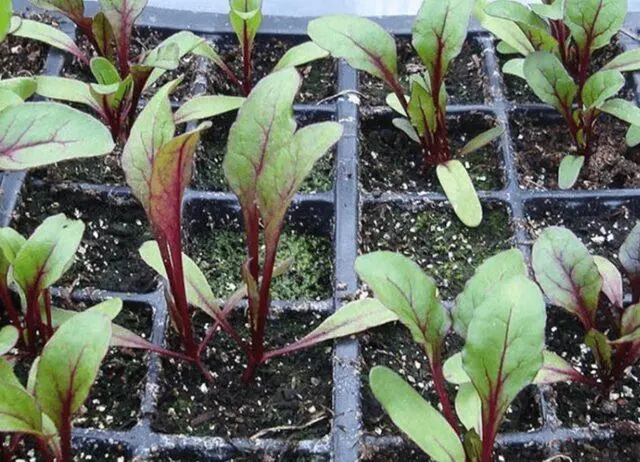
It is recommended to keep beet seedlings in a closed container for no more than 1,5 months, otherwise it will outgrow
When to plant beets for seedlings in the Urals
In the Urals, spring comes at a later date, so beet seedlings are usually sown at the end of April. In this case, you can transfer it to the garden in the second half of May after the onset of warm weather.
When to plant beets for seedlings in Siberia
As in the Urals, it is necessary to plant beets in Siberia in the second half of April towards the end of it. Seedlings will have time to get stronger in 20-25 days just in time for the final arrival of spring.
Selection and preparation of seeds
In order for beet seedlings to sprout safely, the seeds need to be prepared. The process looks like this:
- The material is sorted out, poured into a container with cool water and left for ten minutes. At the end of the term, the seeds that remain floating on the surface are thrown away and only those that have sunk to the bottom are left.
- Planting material is soaked in a solution of potassium permanganate for 20 minutes. The liquid should be pale pink, otherwise the grains will get a chemical burn and die.
- After disinfection, beet seeds are placed in clean warm water and left for five hours. Then the material should be slightly dried.
- Prepared seeds are placed on a well-moistened gauze or cloth, the substrate is folded in half and left in a warm place at 22 ° C.
During germination, planting material is periodically sprayed from a spray bottle. After the appearance of sprouts, the beets are transferred to the ground or to a box with earth.
Soil preparation
Before germinating beets on a plot or in a box, it is necessary to prepare the substrate. The culture prefers loose and aerated soil with low acidity. To prepare it, you can mix peat, humus, turf, wood ash and sand in a ratio of 2: 1: 1: 1: 0,5.
For disinfection, the substrate is recommended to be calcined in an oven at 200 ° C for 20 minutes. In this case, fungal spores and pest larvae will not remain in the soil. For reliability, you can shed the soil with Fitosporin or a weak solution of potassium permanganate.
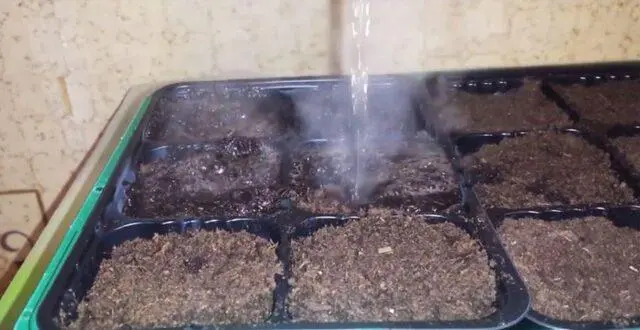
Instead of processing in the oven, the soil for beetroot seedlings can be scalded with boiling water from diseases and pests
Tare selection
It is recommended to grow beets in plastic or biodegradable containers. Suitable for sowing seeds:
- cups of sour cream or yogurt;
- cut plastic bottles;
- ordinary flower pots;
- peat cups.
You can use both small individual containers and wide, but shallow boxes. A container with walls about 10 cm high is optimal for seedlings. Drainage holes must be made at the bottom, it is also desirable to treat the container with potassium permanganate for disinfection.
Wooden containers for beetroot seedlings are not recommended. Such containers are less amenable to disinfection and often become an ideal breeding ground for fungi and pests. As a result, beets already in the early stages of cultivation begin to suffer from diseases.
Ways to plant beets
For seedlings, beets are most often planted at home or in a greenhouse without heating. There are several popular ways to sow seeds.
A warm garden
You can sow beets in seedlings on a warm bed in an unheated greenhouse or in a garden if spring has already come, but cold snaps are still possible. The place is prepared like this:
- Dig a small pit for culture about 35 cm deep.
- Half fill the hole with compost, manure and straw.
- A thick layer of soil is laid on top of the organic material until the height of the bed is about 40 cm.
- On the resulting elevation, grooves for seeds are prepared about 20-40 mm deep with a distance between rows of 25 cm.
- Planting material is placed in the soil at intervals of 10 cm and covered with earth, lightly tamping.
- Seedlings are watered abundantly and covered with foil for the first time.
The organic layer on a warm bed will gradually overheat, releasing heat upward. Due to this, the planting material will not freeze even during a sudden cold snap. It will be possible to transfer beets to a permanent place when a stable daytime temperature of about 18 ° C is established.
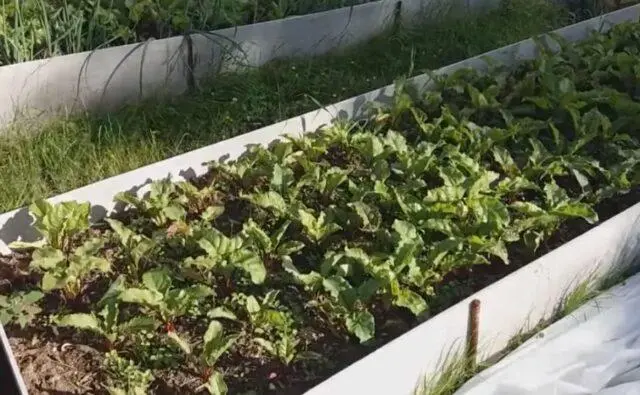
To prevent the raised bed from crumbling, it is recommended to strengthen it along the edges with boards or plastic panels.
in cups
A popular method of sowing beets for seedlings suggests using individual containers for growing. This simplifies the care of the culture and allows you not to injure it once again during transplantation. The sowing algorithm is very simple:
- The cups are covered with a nutrient substrate from garden soil in combination with peat, humus and sand, retreating 1 cm from the edge.
- The soil is properly shed with settled warm water.
- A hole about 4 cm deep is made in the center of the container.
- 2-3 beet seedlings are placed in the soil in each cup and covered with earth on top.
At the end of the procedure, the soil is moistened again, but this time a spray bottle is used so as not to wash out the seeds.

Peat cups are best suited for beet seedlings – you can transfer the crop to the garden directly in them
Beet seedlings in a snail
With a lack of space in the apartment, you can grow beet seedlings in rolls, or snails. Planting seeds is carried out as follows:
- From foamed polyethylene about 2 mm thick, tapes are cut 10-12 cm wide and up to 1 m long.
- The strips are laid out on the table and carefully rolled into rolls, while falling asleep between the layers of the nutrient substrate.
- Finished snails are tied with a thin rope to keep their shape.
- In accordance with the photo of the beet seedlings, the rolls are placed vertically on saucers or a large tray and water is poured into the tray.
- If necessary, pour more soil into spiral rows.
- Beet seeds are distributed along the grooves at intervals of 4-6 cm.
Cultivation is carried out according to the standard algorithm – the sprouts are regularly moistened until they are transferred to the garden.
You can sow seeds even without the use of soil. Planting material in this case is laid in well-moistened napkins or strips of toilet paper and also folded into a snail. But this method is not intended for long-term germination – the seedlings will need to be transferred to a more nutrient medium immediately after the first leaves appear.
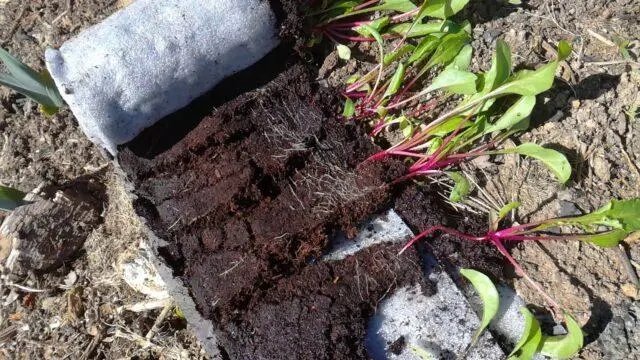
The disadvantage of the roll growing method is that beet seedlings are often stretched.
Beet seedling care
When growing beets through seedlings, you must follow the basic rules of care. Even at home, vegetable crops require attention.
Watering
When growing beet seedlings, it is necessary first of all to provide the culture with high-quality moisture. The soil in the containers should not dry out, otherwise the seeds will not be able to develop. You need to moisten the soil often, but at the same time, liquid stagnation should not be allowed, as the beet roots can rot.
Additional fertilizing
For successful development, beet seedlings need to be periodically fed with useful substances. Usually, before being transferred to the soil, fertilizers are applied twice – after the formation of the initial two leaves and during a dive.
For the first time, seedlings are watered with infusion of chicken manure or a solution of complex minerals with a nitrogen content is added. After diving, potassium and phosphorus, as well as boron, molybdenum and copper, must be added to the soil. For fertilizer, you can use ready-made liquid mixtures for vegetable crops or wood ash.
Dive
When growing beets on a warm bed or in wide boxes, it is necessary to dive after the appearance of cotyledon leaves. The procedure prevents entangling of the roots of individual plants and allows you to provide optimal conditions for each of the mature seedlings.
During the dive, it is necessary to thin out the seedlings by removing all weak and stunted specimens from the containers. Between strong healthy sprouts leave about 7 cm of space. When transferred to individual containers, seedlings must be removed from the soil very carefully, without injuring the root system. It is not necessary to shorten the underground processes.

It is recommended to dive and transfer beet seedlings immediately after the next watering.
Hardening
At home, beet seedlings develop in warmth, and after being transferred to the ground, they face differences in day and night temperatures. Before planting the crop in the garden, it is necessary to carry out preliminary hardening. It will help make the seedlings less sensitive to the effects of cold, wind and direct sunlight.
Usually hardening for beets is performed as follows:
- About two weeks before transferring to the garden, the seedlings are moved to a cooler room, lowering the temperature by about 3 ° C.
- Open the window for fresh air, but close it at night to prevent hypothermia of the plants.
- After 4-5 days, airing is left, including at night, or the seedlings are rearranged on a glazed balcony.
- On the 7th-8th day, containers with sprouts begin to be taken out into the street during the daytime in warm weather.
Ten days after the start of hardening, the seedlings are finally left on the balcony or in the open air until they land on the garden.
When and how to transplant beet seedlings in open ground
Beet seedlings are transferred to open soil on average one month after sowing the seeds, when 3-4 true leaves are formed. The bed is located in a well-lit area of the garden, the soil is dug up in advance and fertilized with complex minerals and organic matter. The acidity index of the soil is reduced to neutral.
A video about planting beet seedlings in the ground offers the following algorithm:
- Holes about 10 cm deep are prepared on the beds – the roots of the seedlings should fit entirely in them.
- Beets are placed in pits, leaving 8 = 10 cm between the bushes, and fill the voids with soil, lightly tamping.
- Plentifully water the beds and cover with non-woven material until the seedlings take root.
Landing should be carried out in the evening after sunset or in cloudy weather. In bright sun, seedlings cannot be transferred to the garden, as this will negatively affect survival.
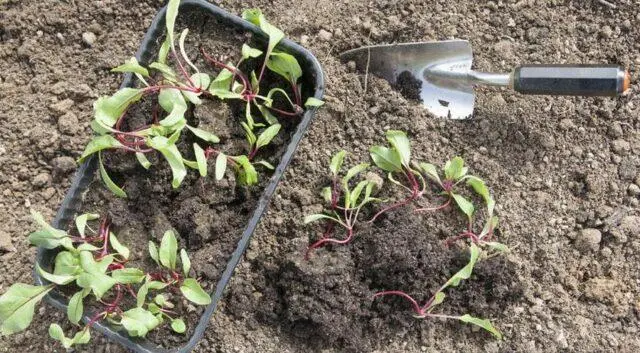
It is best to plant beet seedlings on a small hill to avoid moisture stagnation.
Problems in growing beet seedlings
Beets do not belong to capricious crops and, subject to the basic rules, germinate easily. But sometimes gardeners face difficulties and problems.
Beets do not rise
With proper sowing of beet seeds, the first shoots appear in 7-10 days. The lack of seedlings can be caused by several reasons:
- Poor quality planting material. Even good seeds can lose their germination if stored for too long, drying out or freezing. It is recommended to use for seedlings material collected independently or purchased from a reliable manufacturer no earlier than in the previous season.
- Neglect of preparation. If seeds, soil and containers are not disinfected, planting material immediately after sowing into the soil may suffer from fungi and die.
- Violation of growing conditions. Beets need warmth and sufficient light to thrive. If the container with planting material is in a too cold and shaded room, the seeds germinate much more slowly, and sometimes do not germinate at all.
Too thorough disinfection can damage the culture. If you soak beets for disinfection in a concentrated solution of potassium permanganate or fungicide, the seeds will get chemical burns and die.
Seedlings stretched out
When grown at home, beetroot seedlings are often drawn out. This usually happens due to lack of lighting, especially if the spring turned out to be cold and cloudy.
When pulling seedlings, it is necessary, first of all, to rearrange the container in a brighter place. Once a day, it is recommended to slightly rotate the container. If the sun illuminates the sprouts from only one side, the beets will twist and begin to wither.
Thinning young greenery helps to cope with pulling seedlings. Seedlings that are too close together shade each other and also constantly compete for moisture and nutrients.
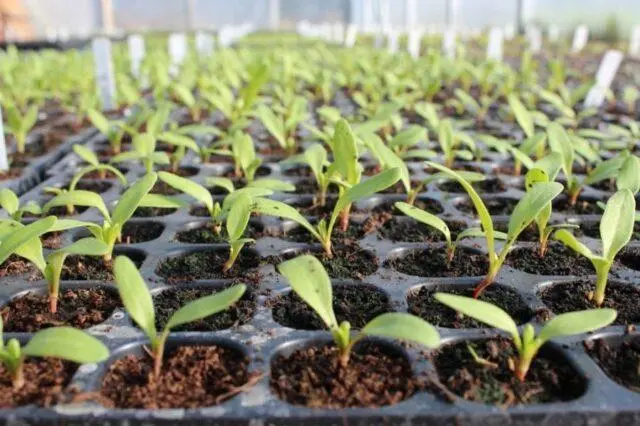
Beets are less likely to suffer from stretching when sprouting in individual cups
Wound pests
If beet seedlings sprouted safely, but then began to wither rapidly, the problem is most likely caused by pests. At home, they infect seedlings with careless soil preparation before sowing seeds. If you do not calcine the garden soil and do not spill it with potassium permanganate, the larvae of beetles and butterflies that eat the roots and leaves of beets may well remain in it.
Remove pests allow infusion of onion peel, tobacco dust, a solution of laundry soap with the addition of wood ash. It is necessary to carry out treatments when the first signs of oppression of seedlings appear. If individual seedlings have suffered too much, they must be removed from the container immediately, since they will no longer grow.
Conclusion
It is necessary to plant beets for seedlings in compliance with the terms and rules for growing crops. You can sow seeds both in a common box and in separate containers, but in both cases it is important to pay attention to the preliminary preparation of the material, soil and containers.









